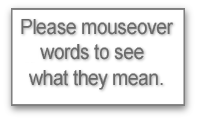Science news - extreme biology
19-September-2010
 Extreme biology
Extreme biology
The secret to success in combining a research career in science with family life is simple, says Anna Amtmann – and surprisingly old-fashioned. “Marry the right man,” she laughs.
“Or rather a man with the right job – another scientist. I had twin babies when I was a postdoc in York and both our families lived on the continent, so we had no support. I would feed my two babies then drive in, in the middle of the night, to look after my cell culture.”
“If my partner had been in industry and out working all day we wouldn’t have had the flexibility to say, ‘You stay with them for an hour while I go work, then I’ll look after them while you do.’ There’s also the acceptance of the lifestyle of a scientist – working evenings and weekends often – which can be difficult for a non-scientist.”
Salt stress
So what exactly is Dr Amtmann’s work? The title of one of her most popular undergraduate courses – extreme biology – covers a big chunk of it, she says. “We're interested in how plants respond to what is called abiotic stress. We're looking in particular at lack of water and high salinity. All our crops – except beetroot which is related to a marine plant – are very sensitive to salt levels.”
Sodium is always toxic to cells, whether plant or animal, she says. “Our proteins like to be surrounded by potassium, but if you put them in a salt solution they disintegrate. But a salty environment isn’t a problem for us animals, because we’re still carrying salt water around with us in the form of blood.
“So all our cells are bathed in salt and have mechanisms to pump it out and replace it with potassium. In animals those mechanisms are the main pump for transporting other materials, such as sugars and amino acids, through cell walls.”
Plant guinea pigs
But when plants evolved out of the sea their transport system changed, she says. “Instead of a sodium-potassium pump across the cell wall, plants have a proton pump that works on pH gradient. So plants have forgotten how to deal with sodium. There are no higher plants in the sea – and very few on the beach.”

Plant scientists often work with Arabidopsis thaliana, says Dr Amtmann. “The common name is mouse-ear cress and it’s our guinea pig. Fully sequenced, everything known, great to work with. But we’ve recently started working with a closely related species called Thellungiella halophila or salt cress.
"The particular species we work with comes from China. But they've been found all over eastern Europe and America. Salt cress has only recenlty been introduced to labs.
Tough cookie
"Thellungiella is a plant that's very similar to Arabidopsis. It's not the same species but it is a closely related one. Thellungiella shares more than 90% of its genome with Arabidopsis.
The reason we're so interested in it is that, unlike Arabidopsis, it can tolerate cold, high salt concentrations and low levels of nutrients. It grows for example in the Yukon in Canada. It is a real tough cookie.”
Other plants, such as cactuses and sugar-beet, that can stand extreme conditions look very different to normal plants. "You can tell by looking at them that they are extremophiles. Look at cactuses with their thick skins or the beet with its huge mound of sugar. But little Thellungiella looks quite ordinary. It has soft leaves, maybe a little more waxy. It has fine roots. Its metabolism seems perfectly normal.”
Rapid change
This makes it a really nice research tool, she says. "We want to know what makes this plant so tolerant of conditions that would quickly kill other plants. Then we might be able to find something that can easily be transferred onto economically important crops."
One of the big changes in biology in recent years that makes this more likely is that scientists can now sequence genomes much faster than before, she says. "Biology has changed so rapidly. We are doing things people couldn’t have imagined ten years ago.
"Where once we looked at one gene and it took us months, we can now look at the expression of a whole genome under ten different conditions in an experiment that takes maybe two days.
“We don’t yet have the sequence for Thellungiella. But I expect we soon will.”
More help with words
| breed | cell | conception | DNA | element | fertile | fertilisation |
| gene | inherit | membrane | molecule | protein | protoplasm | species |
For other websites and resources relevant to this science story try the

